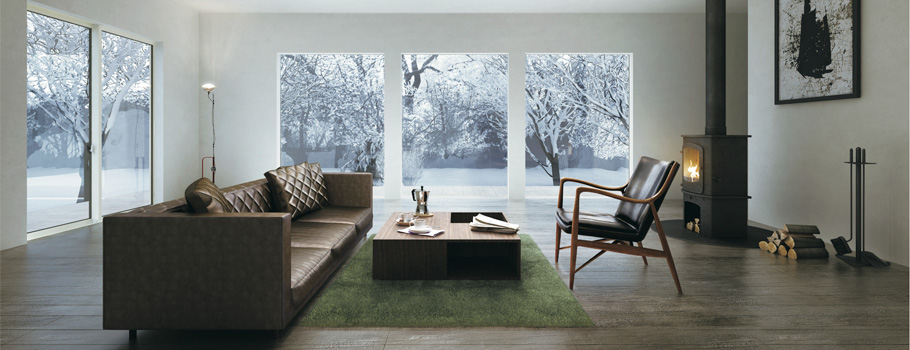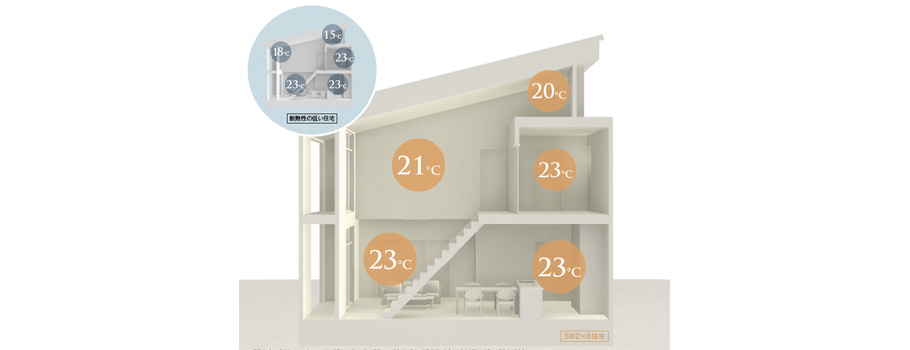LIXIL makes pioneering water and housing products that solve everyday, real-life challenges, making better homes a reality for everyone, everywhere.
- Global Site
-
- English
- Japanese
- Brand Sites
Global
- Global Site
-
- English
- Japanese
- Brand Sites

Updated: Mar 8, 2018
Traditional Japanese houses are constructed with deep eaves, wooden corridors and verandas, and paper sliding screens. These and other ingenious designs improved ventilation in the house, providing comfort in Japan's hot and humid climate and protecting against the long spells of rain, dampness, and summertime heat.
But Japanese houses are also often poorly insulated against the cold. Many people complain of the chill running through their homes in winter.
According to surveys conducted by LIXIL in 2015, people considering buying a home and those living in newly-built houses shared similar concerns. The top three worries consisted of high utility bills, concerns about condensation, mold, and mites, and houses being cold in the winter and hot in the summer.
The main cause for all of these concerns is poor insulation. As a result, even when houses are heated, temperature differences occur within and between rooms, and heat escapes quickly. Dew also condenses on windows because of the difference in temperature outside.
But LIXIL's survey also revealed that, despite the level of dissatisfaction over insulation, frustrations remained even after rebuilding or renovating homes. During the homebuilding process, many homeowners tend to still prioritize conveniences such as their baths, toilets, and kitchens, or cleanliness rather than insulation.
The Health Benefits of Insulation
Many people in Japan have come to believe that houses are just naturally cold in winter. However, according to Tanji Hoshi, professor emeritus of Tokyo Metropolitan University, insulation is the key to a healthy life. In the U.K., for example, insulation in housing is considered a basic human right, and construction regulations to prevent excessive cold indoors have been put in place to reduce health risks. In Japan, however, the role of home insulation in maintaining a healthy life has only recently begun to receive serious attention.
Improving insulation and making buildings more airtight helps to keep occupants healthy. For example, during the winter in a poorly insulated house, temperature differences of more than 10°C between a heated living room and the bathroom are not unusual. This difference alone can cause a sudden change in blood pressure known as "heat shock." In fact, data published by the Japanese Society for Hygiene1 shows that deaths in the home from cardiovascular diseases such as heart attack or stroke rise sharply in winter.

In well-insulated homes, temperature differences are less felt, which can contribute to fewer cases of "heat shock" during the winter
According to a nationwide survey2 conducted by Professor Hoshi and others, of 10,257 people who changed to a warmer residence, moving led to in a wide range of health improvements, including allergies, hypertension, arthritis, pneumonia, diabetes, heart disease, and cerebrovascular disease. This is thought to be due to a combination of factors including less mold and fewer mites following the reduction in condensation, and improved air quality from better heating and ventilation systems.
"Enhancing the insulation and airtightness of doorways, walls, floors, roofs and other areas to prevent heat transfer is important for maintaining a comfortable indoor temperature year round," says Professor Hoshi.
Living in the "House of the Future"
LIXIL opened its Sumai Studio- which translates to Living Studio - in October 2017 to allow people to experience firsthand the benefits of a well-insulated house, an aspect difficult to appreciate from photos or floorplans.
Winter and summer environments are recreated inside the studio. In the Winter Studio, which simulates an outdoor temperature of 0°C, visitors can experience three different levels of insulation for windows and walls: the "Old House" (1980 Standard), "Today's House" (2016 Standard), and the "Future House" (HEAT 20 G23). In the "Old House," the temperature difference between the heated living room and the adjoining washroom is more than 10°C, while in the "Future House" the temperature is more consistent between rooms, with a variance of just 5°C.

At LIXIL's Sumai Studio, a thermal camera (right) displays the temperature differences in the standard home of Japan today
Thermal cameras also provide a visual representation of temperatures near windows, and temperature differences between rooms. The Summer Studio has a living room that recreates the effect of the midsummer sun on indoor temperatures, enabling visitors to experience what it feels like to reduce the effect of the midday and afternoon sun. Better insulation also keeps out the summer heat, improving the efficiency of air conditioning, and providing a comfortable indoor environment year round.
"Sumai Studio is not a typical showroom to see products, but a place where visitors can experience for themselves what the interior atmosphere is like, and how they can live there comfortably," explains Sumai Studio Director Ryu Kameshita.
"Better insulation and making buildings more airtight keeps families healthy and comfortable, while also helping to create a low-energy home with minimal energy loss. Our aim is to convey these benefits to people who are considering building or renovating a home, and help them live healthily and comfortably," he says.
1 Hirofumi HAYAMA et al., "Effects of Living Environment on the Cause Death, No.1: Relationship between Climate Conditions, place of death and rate of death," 68th Japanese Society for Hygiene Conference, 2009 (Japanese)
2 Toshiharu IKAGA, Rika EGUCHI, Shuzo MURAKAMI, Atsushi IWAMAE, Tanji HOSHI, etc.: "Investment Evaluation of Housing Insulation Considering the Non-Energy Benefits (NEB) Provided by Maintaining Health," Journal of Environmental Engineering (Transactions of AIJ), Vol.76,No.666,2011.8
3 Housing with a good insulation grade as determined by HEAT20 (Investigation Committee of Hyper Enhanced Insulation and Advanced Technique for 2020 Houses), a committee established by private organizations and experts for the purpose of maintaining health and improving comfort for occupants.
Our Stories
- Backing People and Passions to Drive Innovation
- How Toilets in Schools are Catalyzing Change in Communities
- Building the Future by Recycling the Past
- Reinventing Consumer Connections in the World's Largest E-commerce Market
- Tackling Household Water Inefficiency in a Water-Stressed World
- Plugging the Plumber Shortage
- Pioneering Solutions to a Sewage Crisis in Rural Alabama
- Meet the Citizen Developers Changing How We Work
- Design and Brand Identity Transformation at LIXIL
- Three Changes to Prepare Europe’s Sanitary Industry for Growth
- Three Steps to Creating an Inclusive Culture
- From Linear to Circular: Giving Products in Your Home a New Lease of Life
- Crafting Unique Experiences as well as Products
- GROHE X: A Digital Brand Experience
- Design-led Innovation Delivering True Value
- Responsible Use of Plastics
- Empowering our People for an Agile Future
- Turning the Waves of Change into Opportunities
- SATO Tap: a New Handwashing Solution for All
- New Ways of Working Take Flight at LIXIL
- INAX: Rituals of Water
- Refreshing our sanitation targets, standing firm on our commitments
- Developing Attractive and Differentiated Products
- Conserving Water: The New Normal
- Insulating For a Warmer and Healthier Home
- Open Kitchen, Open Communication
- Tackling Open Defecation in India
- Shaping the Future of Faucets, One 3D Layer at a Time
- Bathed in Culture and Tradition
- Remodeling the Housing Market
- LIXIL's AQUA CERAMIC makes bathroom stains a thing of the past
- The Technology of Water
- Tackling Challenges in Global Sanitation and Hygiene
